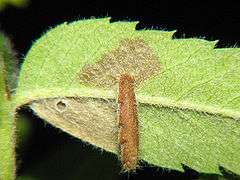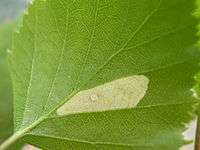Coleophora serratella
| Coleophora serratella | |
|---|---|
 | |
| Scientific classification | |
| Kingdom: | Animalia |
| Phylum: | Arthropoda |
| Class: | Insecta |
| Order: | Lepidoptera |
| Family: | Coleophoridae |
| Genus: | Coleophora |
| Species: | C. serratella |
| Binomial name | |
| Coleophora serratella (Linnaeus, 1761)[1] | |
| Synonyms | |
| |
Coleophora serratella is a moth of the Coleophoridae family. It is found in Europe (except the Balkan Peninsula), Japan (Hokkaido) and North America.[2]

Pupa

Damage
The wingspan is 11–14 millimetres (0.43–0.55 in). The moth flies in June depending on the location.
The larvae feed on birches, elms, alders, hazels, apples, Crataegus, Sorbus, willows, Comptonia peregrina and Quercus wislizenii. They create a strongly curved youth case. The adult case is a tubular leaf case. It is trivalved and about 7 millimetres (0.28 in) long. The mouth angle is about 30°. It is straw coloured. Larvae start feeding in September and continue to the end of October. They hibernate in their case, and resume feeding in April.[3]
References
- ↑ "Coleophora serratella (Linnaeus, 1761)". Fauna Europaea. 2.6.2. August 29, 2013. Retrieved February 20, 2015.
- ↑ "Descriptions Of Nine New Species Of The Genus Coleophora From Japan, With Notes On Other Species (Lepidoptera: Coleophoridae)" (PDF). Hokkaido University.
- ↑ bladmineerders.nl
External links
This article is issued from Wikipedia - version of the 3/31/2016. The text is available under the Creative Commons Attribution/Share Alike but additional terms may apply for the media files.